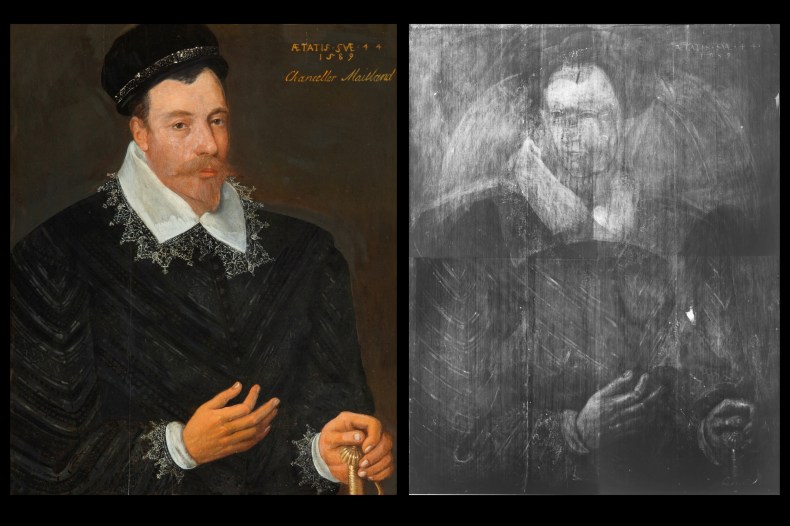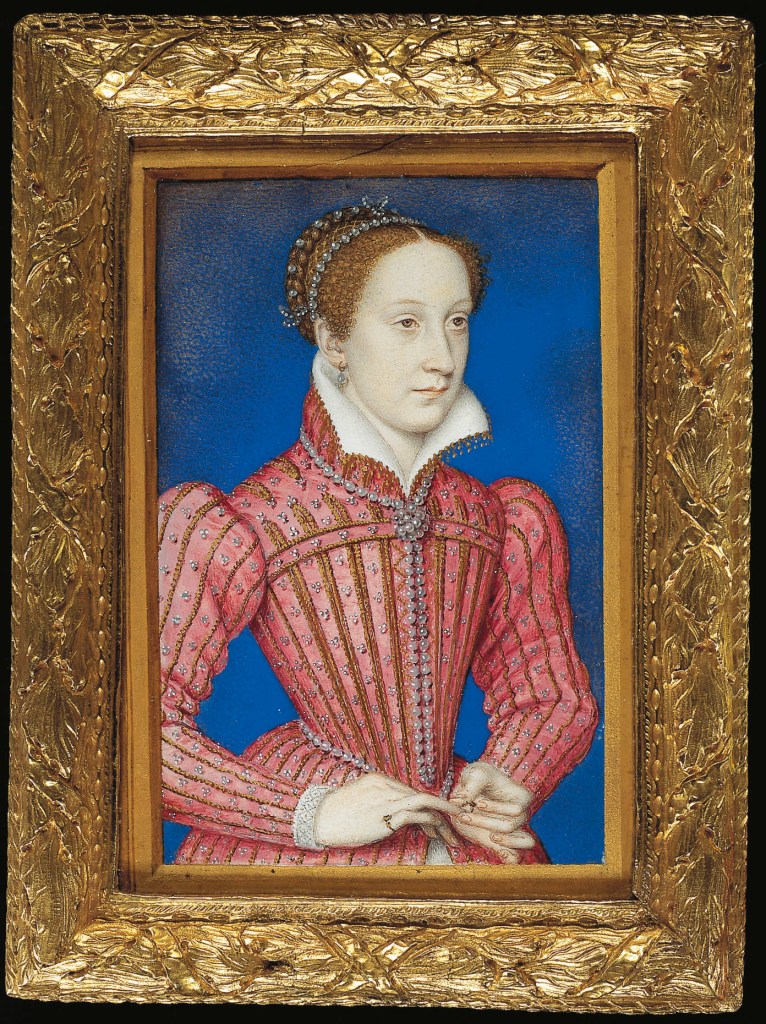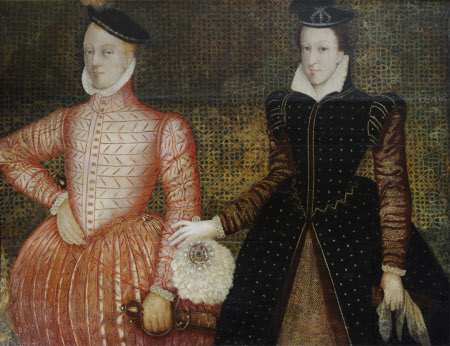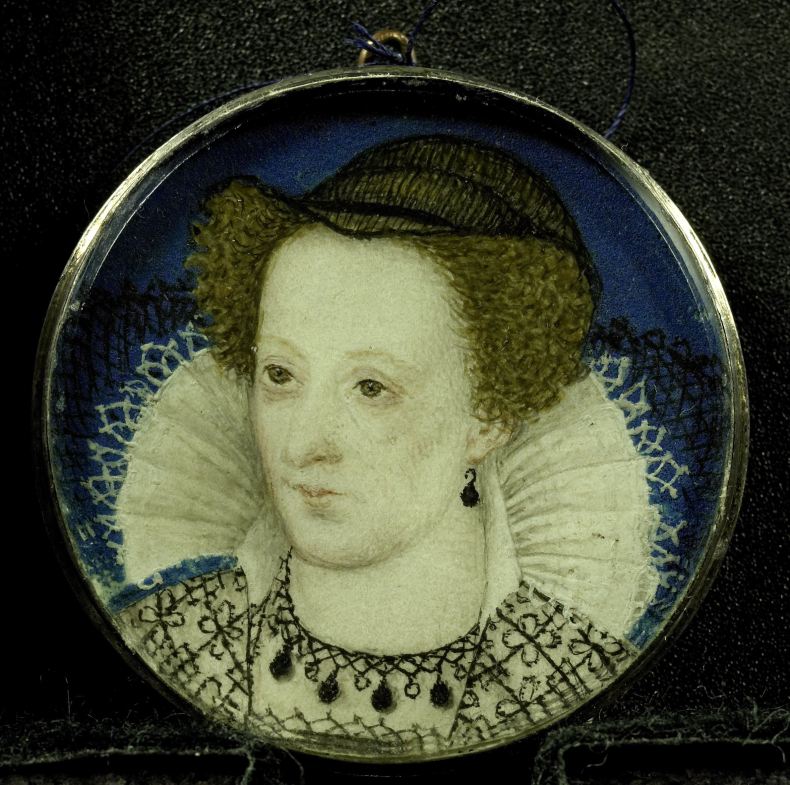An unfinished portrait of Mary, Queen of Scots (1542–87) has recently been discovered, via X-ray, hidden under a 1589 portrait of her son’s lord chancellor, Sir John Maitland of Thirlestane, which hangs at Ham House. This was examined in preparation for an exhibition ‘Art and Analysis: Two Netherlandish painters working in Jacobean Scotland’ (a collaborative project between the National Galleries of Scotland, the Courtauld Institute and the National Trust), currently on show at the Scottish National Portrait Gallery.

Left: Adrian Vanson’s portrait of Sir John Maitland, 1st Lord Maitland of Thirlestane (1589); right: X-ray view of the same painting, showing the portrait of a woman believed to be Mary, Queen of Scots National Galleries of Scotland
The present author suggested Vanson as the artist of the Thirlestane portrait and Caroline Rae, a former Caroline Villers Research Fellow at the Courtauld, undertook the technical analysis that included the X-ray. The facial physiognomy matches the features of Mary in examples of the so-called ‘Sheffield portrait’, which are based on miniatures of her painted by the celebrated Nicholas Hilliard when Mary was in captivity. Her then-gaoler, the 6th Earl of Shrewsbury allowed her to sit for at least two portraits – staggeringly this is more than the number of portraits surviving from her personal reign in Scotland. With time on her hands Mary became pro-active in distributing her image to her supporters, from asking for portraits of her from her ambassador in France to giving one of her attendants a miniature portrait of herself on the very morning of her execution.
Sanctified and demonised in equal measure during her life, Mary has been an obvious subject for artistic representations ever since. This reached its zenith in the 19th century’s cultish appreciation of her, which produced Schiller’s play, Donizetti’s operatic response, and countless history paintings – before various reductive misinterpretations in more recent appearances in film and television. But the newly discovered portrait highlights the fact that there were very few portraits painted of the queen during her lifetime – and we have to wonder why. Why was there no programmatic artistic production, of the sort her English cousin encouraged?

Mary, Queen of Scots (1558), Francis Clouet. Royal Collection Trust/© Her Majesty Queen Elizabeth II 2017
The young Mary was sent to France for safety following Henry VIII’s barbaric war of the ‘Rough Wooing’, leaving behind an iconography limited to coinage. Once in France she sat to François Clouet, for a series of spectacular drawings, which record her transition from child-queen regnant, to French queen consort, to young widow, and the last of these, showing her in white mourning, was widely copied and is one of the best-known images of her. The finest Clouet image of Mary is his 1558 watercolour of her in a pink dress placing a ring on her finger (in the Royal Collection), and it was copied for a miniature double portrait of her and her first husband, François II, crowned and praying, for her mother-in-law Catherine de’ Medici’s book of hours (in the Bibliothèque nationale de France).
Engraved portraits were printed in France and coins and medals were produced there by Guillaume Martin, and in Scotland by John Acheson, amongst others, including paired images with François, or with her second husband, Henry Stuart, Lord Darnley. Intriguingly, a double portrait with Darnley appears to be, potentially, the only surviving painted portrait from her turbulent, near-seven year personal rule in Scotland (Hardwick, National Trust), a commemoration of a disastrous match that ultimately led to her downfall.

Henry Stuart, Lord Darnley and Mary, Queen of Scots (c, 1565), British (Scottish) School, Hardwick Hall; © National Trust
Mary fled to England, following Darnley’s murder and the subsequent rebellion and her forced abdication. Elizabeth I had her arrested and she was imprisoned for 19 years until her eventual execution in 1587. With more time in England to consider her iconography after her turbulent few years ruling Scotland, Mary would have realised the role portraiture could play in emphasising her cause. A small, Clouet-esque portrait of the queen in the same bonnet as the double portrait with Darnley (National Portrait Gallery) was perhaps painted during her English captivity, but the best-known image from this time is the ‘Sheffield portrait’ type – a full-length of the queen in black, with her hand resting on a table. Thought to be Jacobean and part of a programme undertaken by her son to rehabilitate her reputation after the Stuart succession to the English throne, these are now thought to be contemporary. Who the commission came from is unknown (and the fact that it’s full of Catholic references makes its production all the more puzzling), but the prime version appears to be the picture at Hardwick, presumably painted by Rowland Lockey, and based on one of the two Hilliard miniatures.
Of the countless copies and versions, one of the most intriguing is a double portrait with her son James VI, dated 1583 (and at Blair Castle), which commemorates the ludicrous proposal of her being released and sent to Scotland to rule jointly with him. There is also the so-called ‘Blairs Jewel’, a miniature of Mary traditionally thought to be the portrait the queen gave away before her execution (at Blairs Museum), which, with another version in the Rijksmuseum, illustrates the production of miniatures of Mary in the last decades of her life.

Portrait miniature of Mary, Queen of Scots, likely to be painted in her lifetime. Rijksmuseum, Amsterdam
This new, palimpsest portrait at Ham House, to be seen only in X-ray form, was probably painted over when the queen’s execution removed any need for showing loyalty to the former-monarch who, when she was alive, could still have escaped her captivity or been released following the planned murder of Elizabeth I, that she herself had sanctioned. It would have been a dangerous picture to display in Scotland before the queen’s death. Ironically, something about it being unfinished and hidden reminds us of the tragic life of its charismatic but unfortunate sitter.
‘Art and Analysis: Two Netherlandish painters working in Jacobean Scotland’ is at the Scottish National Portrait Gallery until 26 January 2018.

Why are there so few portraits of Mary, Queen of Scots?
Detail of an X-ray showing the portrait of a woman believed to be Mary, Queen of Scots, underneath Adrian Vanson's portrait of Sir John Maitland. National Galleries of Scotland
Share
An unfinished portrait of Mary, Queen of Scots (1542–87) has recently been discovered, via X-ray, hidden under a 1589 portrait of her son’s lord chancellor, Sir John Maitland of Thirlestane, which hangs at Ham House. This was examined in preparation for an exhibition ‘Art and Analysis: Two Netherlandish painters working in Jacobean Scotland’ (a collaborative project between the National Galleries of Scotland, the Courtauld Institute and the National Trust), currently on show at the Scottish National Portrait Gallery.
Left: Adrian Vanson’s portrait of Sir John Maitland, 1st Lord Maitland of Thirlestane (1589); right: X-ray view of the same painting, showing the portrait of a woman believed to be Mary, Queen of Scots National Galleries of Scotland
The present author suggested Vanson as the artist of the Thirlestane portrait and Caroline Rae, a former Caroline Villers Research Fellow at the Courtauld, undertook the technical analysis that included the X-ray. The facial physiognomy matches the features of Mary in examples of the so-called ‘Sheffield portrait’, which are based on miniatures of her painted by the celebrated Nicholas Hilliard when Mary was in captivity. Her then-gaoler, the 6th Earl of Shrewsbury allowed her to sit for at least two portraits – staggeringly this is more than the number of portraits surviving from her personal reign in Scotland. With time on her hands Mary became pro-active in distributing her image to her supporters, from asking for portraits of her from her ambassador in France to giving one of her attendants a miniature portrait of herself on the very morning of her execution.
Sanctified and demonised in equal measure during her life, Mary has been an obvious subject for artistic representations ever since. This reached its zenith in the 19th century’s cultish appreciation of her, which produced Schiller’s play, Donizetti’s operatic response, and countless history paintings – before various reductive misinterpretations in more recent appearances in film and television. But the newly discovered portrait highlights the fact that there were very few portraits painted of the queen during her lifetime – and we have to wonder why. Why was there no programmatic artistic production, of the sort her English cousin encouraged?
Mary, Queen of Scots (1558), Francis Clouet. Royal Collection Trust/© Her Majesty Queen Elizabeth II 2017
The young Mary was sent to France for safety following Henry VIII’s barbaric war of the ‘Rough Wooing’, leaving behind an iconography limited to coinage. Once in France she sat to François Clouet, for a series of spectacular drawings, which record her transition from child-queen regnant, to French queen consort, to young widow, and the last of these, showing her in white mourning, was widely copied and is one of the best-known images of her. The finest Clouet image of Mary is his 1558 watercolour of her in a pink dress placing a ring on her finger (in the Royal Collection), and it was copied for a miniature double portrait of her and her first husband, François II, crowned and praying, for her mother-in-law Catherine de’ Medici’s book of hours (in the Bibliothèque nationale de France).
Engraved portraits were printed in France and coins and medals were produced there by Guillaume Martin, and in Scotland by John Acheson, amongst others, including paired images with François, or with her second husband, Henry Stuart, Lord Darnley. Intriguingly, a double portrait with Darnley appears to be, potentially, the only surviving painted portrait from her turbulent, near-seven year personal rule in Scotland (Hardwick, National Trust), a commemoration of a disastrous match that ultimately led to her downfall.
Henry Stuart, Lord Darnley and Mary, Queen of Scots (c, 1565), British (Scottish) School, Hardwick Hall; © National Trust
Mary fled to England, following Darnley’s murder and the subsequent rebellion and her forced abdication. Elizabeth I had her arrested and she was imprisoned for 19 years until her eventual execution in 1587. With more time in England to consider her iconography after her turbulent few years ruling Scotland, Mary would have realised the role portraiture could play in emphasising her cause. A small, Clouet-esque portrait of the queen in the same bonnet as the double portrait with Darnley (National Portrait Gallery) was perhaps painted during her English captivity, but the best-known image from this time is the ‘Sheffield portrait’ type – a full-length of the queen in black, with her hand resting on a table. Thought to be Jacobean and part of a programme undertaken by her son to rehabilitate her reputation after the Stuart succession to the English throne, these are now thought to be contemporary. Who the commission came from is unknown (and the fact that it’s full of Catholic references makes its production all the more puzzling), but the prime version appears to be the picture at Hardwick, presumably painted by Rowland Lockey, and based on one of the two Hilliard miniatures.
Of the countless copies and versions, one of the most intriguing is a double portrait with her son James VI, dated 1583 (and at Blair Castle), which commemorates the ludicrous proposal of her being released and sent to Scotland to rule jointly with him. There is also the so-called ‘Blairs Jewel’, a miniature of Mary traditionally thought to be the portrait the queen gave away before her execution (at Blairs Museum), which, with another version in the Rijksmuseum, illustrates the production of miniatures of Mary in the last decades of her life.
Portrait miniature of Mary, Queen of Scots, likely to be painted in her lifetime. Rijksmuseum, Amsterdam
This new, palimpsest portrait at Ham House, to be seen only in X-ray form, was probably painted over when the queen’s execution removed any need for showing loyalty to the former-monarch who, when she was alive, could still have escaped her captivity or been released following the planned murder of Elizabeth I, that she herself had sanctioned. It would have been a dangerous picture to display in Scotland before the queen’s death. Ironically, something about it being unfinished and hidden reminds us of the tragic life of its charismatic but unfortunate sitter.
‘Art and Analysis: Two Netherlandish painters working in Jacobean Scotland’ is at the Scottish National Portrait Gallery until 26 January 2018.
Unlimited access from just $16 every 3 months
Subscribe to get unlimited and exclusive access to the top art stories, interviews and exhibition reviews.
Share
Recommended for you
‘Anyone who is interested in the Renaissance should be interested in medals’
It may be a small and specialist market, but it is still possible to find exquisite portrait medals at affordable prices
A radical new look at the greatest of Elizabethan artists
Two portraits newly attributed to Nicholas Hilliard will transform our understanding of the artist
‘The most perfect example of the Elizabethan Age’
From its architecture to the treasures it contains, Hardwick Hall is a complete work of art